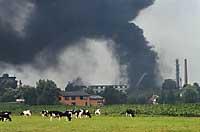Soot and climate change
At its recent meeting in New Delhi, the United Nations Climate Change Commission has again denounced the attitude of the United States. They reiterate that if the Kyoto Protocol is not affirmed, compliance with the Kyoto Protocol will not be possible, that is, carbon dioxide emissions will not be reduced enough by 2012. However, if Russia ratifies the protocol, it will launch it.

Meanwhile, scientists put aside political debate without progress and work. Stanford University's Mark Jacobson team has proposed that soot that has so far been discarded is a more important agent than expected.
Using computer simulations, the influence of coal in atmospheric processes has been studied and its reduction has been shown to produce rapid cooling of the atmosphere, faster than reducing the same amount of carbon dioxide. Reason: Soot disappears from the atmosphere in a few months and CO 2 takes about 200 years.
Soot particles, alone, do not contribute significantly to the greenhouse effect, but when covered by pollutants such as sulfur dioxide. According to Jacobson, the particles absorb much more radiation in this situation.
These results are currently based on several assumptions about particle generation, but call for soot consideration in the climate change debate, as soot reduction can prevent short-term effects. For example, EU standards drive diesel vehicles instead of gasoline, but diesel emit 40-250 times more soot. On the other hand, in Europe and the United States, despite the fact that the main sources of kedar are the construction and farmers' teams, Jacobson considers that the regulations are diffuse.
Buletina
Bidali zure helbide elektronikoa eta jaso asteroko buletina zure sarrera-ontzian











